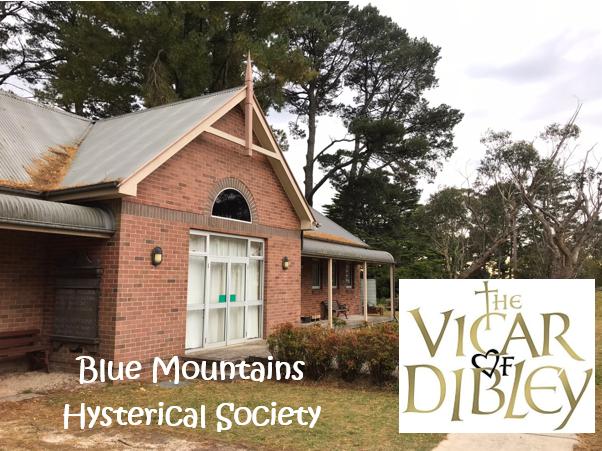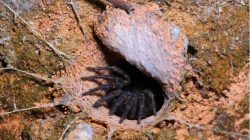Otway Ranges – Conservation Background
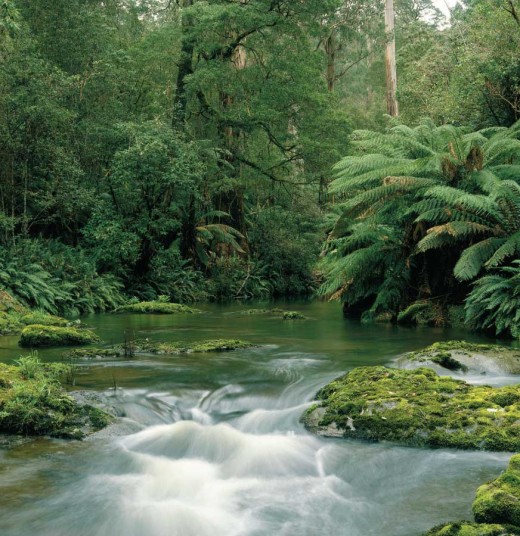 Cumberland River, Great Otway National Park
South-West Victoria, Australia
Cumberland River, Great Otway National Park
South-West Victoria, Australia
.
Conservation Background
.
While we may rightly celebrate the Victorian Government’s establishment of a 102,000 hectare Great Otway National Park in 2005 and 40,000 hectare Otways Forest Park, and celebrate the banning of logging from the Otway Ranges in 2008.
This was an action that held back the destruction of the Otways from the abyss of Bioregional Ecological Extinctions.
One only needs to drive to the Otways from Melbourne via the Princes Highway and Colac (by day) and look out the window to bear witness to the denuded landscape left by Australia’s colonial ancestors and to realise that without the conservation campaign, this was to be the colonial logging fate of the Otways.
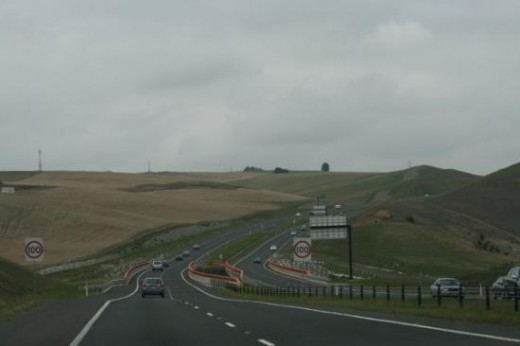 A denuded landscape
Along the nearby Pacific Highway near Colac, Victoria
[Source: http://www.tripadvisor.com]
A denuded landscape
Along the nearby Pacific Highway near Colac, Victoria
[Source: http://www.tripadvisor.com]
.
Much wisdom can be learned from the conservation campaign principles, objective, strategies and methods adopted by Otway Ranges Environmental Network (OREN) in saving the Otway Ranges. That OREN sustained the campaign over an incredible 13 years from 1995 to 2008 are lessons in long term commitment, vigilance and tenacity in community-based campaigning.
The conservation champions, Otway Ranges Environmental Network (OREN), were instrumental in galvanising community support to save the Otway Ranges from deforestation by logging. [>Read: Otway Ranges – Conservation Background].
Yet while the deforestation threat from commercial logging has been effectively removed from the OtwayRanges since 2008, OREN has identified further threatening processes to the survival and integrity of wildlife habitat.
For a comprehensive summary history of Conservation Campaigns concerning The Otways, visit Otway Ranges Environment Network,^http://www.oren.org.au/campaign/intro.htm
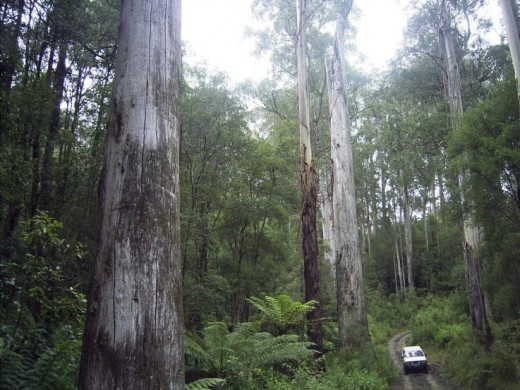 Tall timbers of the Otways saved
Source: ^http://www.deniliquin4wdclub.com.au/Photos.htm
Tall timbers of the Otways saved
Source: ^http://www.deniliquin4wdclub.com.au/Photos.htm
.
.
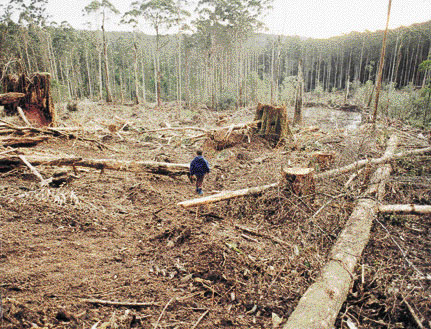 Lest we forget..the Otways not so long ago
[Source: OREN]
Lest we forget..the Otways not so long ago
[Source: OREN]
.
An overview of the Otway Ranges Environment Network’s Otway forest campaign (1995-2005) …lessons learned
[Source: Friends of the Earth, ^http://www.foe.org.au/resources/chain-reaction/editions/95/the-campaign-for-the-otway-ranges/, quoted from Simon Birrell (Otway Ranges Environment Network); ^http://www.oren.org.au/].
‘The Otway Ranges Environment Network (OREN) conducted a successful decade-long campaign to get clearfell logging and woodchipping of magnificent biodiverse native forests banned for all time. OREN’s campaign followed the excellent work of other conservation groups who fought to protect the Otways in the 1980’s and earlier.
The threat to the Otway forests from clearfell logging came to a head in March 2000 when the Bracks’ and Howard governments signed the West Regional Forest Agreement (West RFA). This agreement was an attempt by the woodchip industry to ensure they would get woodchip logs from the Otways, with guaranteed clearfell logging and woodchipping until at least the year 2020.
The West RFA was a money-making dream come true for the woodchippers, and a nightmare for conservationists and the community. Under this agreement at least 3-4 sq kilometres of Otway forest would be clearfell logged and woodchipped annually for at least 20 years.
However history took another path. The Bracks’ government never put into place the legislation required to lock the West RFA into a legally binding agreement, putting the forests and wishes of the community first. Instead, the conservationists’ dreams became legal reality in September 2005, when legislation to establish the 102,000 ha Great Otway National Park and 40,000 ha Otways Forest Park was passed though the Victorian Parliament. The changes to legislation resulting from the National Parks (Otways and Other Amendments) Bill will only allow logging within the Otways Forest Park until 2008 and only under the last sawlog and woodchip licenses which expire in June 2008.
This new legislation is a result of an unprecedented policy decision by the Bracks’ government announced during the November 2002 Victorian State election. The Bracks’ government was re-elected by the Victorian public with a huge mandate to abandon the West RFA signed only two years earlier.
‘No RFA agreement anywhere in Australia has ever been so totally and absolutely dumped before.’
.
So how was this achieved?
In the 10 years that OREN has been active, it conducted an integrated community campaign. That is, it sought to engage many diverse community groups, organisations and individuals with the Otway forest issues that were of direct relevance to the broad community. The aim was to make the arguments against Otway native forest logging easily available to the public and give the average person who wanted to help save the forests something practical and realistic to do within their means.
Much of the media and public outreach that was generated resulted from non-violent direct action by conservationists and local residents. This included protests in the Otways at areas being or proposed to be clearfell logged. Direct action often involved the protesters putting their bodies on the line. One strategy was to live up in the trees on small ‘tree sit’ platforms for weeks or months at a time. This passionate on-ground protest action got violent on a few occasions with frustrated loggers physically attacking the protesters.
Parallel to these protests was a strategic public education and awareness campaign that sought to get the broad community engaged in the campaign to protect the Otway forests. This broader campaign can be roughly broken up into a few critical stages.
From 1996-1998 OREN conducted the “refuse to use Kleenex” or “don’t wipe your bum on the Otways” campaign. Kimberly Clark, an American multinational company who owns the Kleenex brand name, had a license to source 44,000 tonnes of Otway woodchips per year. These woodchips were used to make Kleenex facial tissues and toilet paper. The OREN consumer awareness campaign involved the promotion of tissue paper products made from 100% post consumer waste paper rather than the Kleenex native forest fibre products. Kimberly Clark got the message from their customers and quit the Otways after a two year campaign by OREN.
From 1999-2000 there was a focus on the “Water not Woodchips” campaign which occurred in conjunction with the West RFA process. At issue was the fact that about half of the Otway State Forest is the domestic water supply for over 250,000 people in South West Victoria, including the major regional cities of Geelong and Warrnambool. Scientific research had demonstrated that clearfell logging was reducing both the water yield and quality from the Otway water supply catchments. During this time the region was experiencing a drought and the public was subject to water restrictions. Clearfell logging in the Otways became a personal issue for those who depended on the region for their drinking water.
OREN conducted thorough research and demonstrated that logging was economically woodchip driven and that the economic value of water lost though logging was far greater that the value of the woodchips taken out. OREN made presentations to local governments throughout South West Victoria. The Greater Geelong City Council, Surf Coast Shire and Warrnambool City Council all came out opposed to logging within their Otway water catchment areas and expressed these views as part of the West RFA process.
The final part of the campaign from 2001 – 2002 was a political campaign where the Bracks government changed it’s policy on the West RFA. This largely occurred due to the preparedness of both the Victorian government and members of OREN to engage directly in dialog about the future of the Otways. OREN representatives spent many hours as a part of an Otway Reference Group that met with ministerial advisers and forestry bureaucracy, to discuss contentious coupes and try to find a compromise between what needed to be logged each summer and what should be preserved. The compromise was very difficult for both sides.
However over time OREN developed a critical relationship with the elected government based on integrity and trust. When compromises were reached, OREN always stuck to what was agreed despite some important forest areas being logged as a result of compromise.
This high level of integrity resulted in the government coming to the understanding that OREN was all about achieving positive practical outcomes rather than attempting a fundamentalist “all or nothing” political campaign.
In the end the Victorian Government’s Otway announcements made during the November 2002 state election came as a surprise to many but were not so much of a surprise to those in OREN who had worked with the broad community and Victorian government to achieve this fantastic outcome for the Otway forests.’
.
‘The Australian Otway forests saved from Kimberly-Clark’
[Source: ^http://kleercut.net/en/otway-forests-saved-from-kc].
‘How do you stop Kimberly-Clark from turning valuable native forests into Kleenex? Just take a look at this new website from Otway Ranges Environment Network (OREN). The site provides an historical overview of this landmark campaign to protect the Otway forests, in Victoria, Australia.
From 1995-2008 the “refuse to use Kleenex tissues” campaign fought to save the Otway forests from becoming woodchips for Kimberly-Clark toilet paper and tissues. Through OREN’s perseverance, consumer awareness activities, and the support of communities and area residents, the campaign led to the protection of the Otway forests within the Great Otway National Park. The campaign’s final victory has ensured that clearfell logging and woodchipping of all native forest on public land in the Otways is banned and illegal.
Though they deserve a rest after all the hard work OREN’s dedication to forest protection continues, as they use their expertise to assist other campaigns battling Kimberly-Clark around the world. Since Kimberly-Clark is turning Canada’s ancient Boreal Forest into disposable tissue products, OREN supports Greenpeace’s global campaign to stop ancient forest destruction in North America.
Greenpeace campaigners and forest protectors worldwide are all wondering the same thing: if Kimberly-Clark can get out of the old growth Otway forests in Australia why can’t they get out of all endangered forests?’
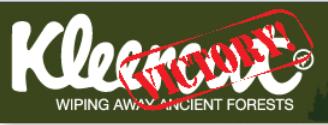 .
.
.
Otways (201106)
.
Colac district conservationists hope a dog could be the key to saving Australia’s tiger quoll population. Employees of the Cape Otway Centre for Conservation Ecology have been busy training two-year-old Badger, the tiger quoll detection dog, to locate scats from the endangered tiger quoll population.
Program leader Kellie Leigh is training Badger, an Australian shepherd, with the aid of three tiger quolls kept on site in a custom-built sanctuary named the “Qualloseum”.
Staff feed the quolls a varied diet and the quolls, each of which is about 12 months old, provide fresh scats for Badger’s training program.
“Three down the back are providing poo to train badger with,” Ms Leigh said.
“We’re training him to track down scats, so if he can find like a latrine site then we can sample it, take DNA from all the poo and figure out how many quolls are using that latrine site, what sex they are,” she said.
“If we do find poo we obviously know they’re around, then we can trap them and collar them and find out what habitats they’re using, what they’re feeding off and what the threats are and the causes of decline.”
Conservationists hope new detection methods will help find populations of native tiger quolls in the Otways.
Three tiger quolls live at Cape Otway in a custom-built sanctuary named the “Qualloseum”. Cape Otway Centre for Conservation Ecology program leader Kellie Leigh hopes Badger the dog will help conservationists find native tiger quoll populations around the Otways.
Ms Leigh said tiger quoll numbers in the Otways were so low that environmental authorities, who use remote cameras to survey the animals, had not detected the marsupial predator for “about seven years”.
“It means the population has declined dramatically and those sorts of survey techniques are less reliable,” Ms Leigh said.
But she said a recent “fairly reliable sighting” on private land at Johanna had reaffirmed the need to assess the remaining population.
The centre also uses remote cameras, triggered by motion and heat, to look for tiger quolls.
.
.
Otways (201104)
.‘Weed Control: Boneseed and Bridal Creeper’
In 2011, The Victorian Government’s Department of Sustainability and Environment (DSE) received funding under the Caring for Our Country (CFOC) Grants Program from the Commonwealth Government to develop, implement and deliver the Community Protection of the South East Coastal Plain Bioregion Project (SECP Project). The SECP Project will protect a biodiversity-rich section of the South East Coastal Plain Bioregion of Victoria that provides habitat for 20 species listed under the Environment Protection and Biodiversity Conservation Act 1999. Through the control of Weeds of National Significance (WONS), the SECP Project will reduce the impact of the Weeds of National Significance (WONS), boneseed Chrysanthemoides monilifera subsp. monilifera and bridal creeper Asparagus asparagoides to biodiversity along a National Heritage nominated coastline. The SECP Project – a community driven initiative with agency input – will result in a concentrated, strategically coordinated and collaborative effort to increase the effectiveness of current weed control works, whilst also increasing the capability and connections within the local community. .The SECP Project aims to:
- Reduce the impact of WONS on biodiversity within the Otways-Eden area by undertaking collaborative activities to bring core infestations of boneseed and bridal creeper under strategic control, and
- Increase coastal community awareness by engaging and supporting community organisations in coastal and marine rehabilitation, restoration and conservation actions.
DSE has outsourced consulting firm Beacon Ecological to produce a reportDEC set up the ‘Otway Community Conservation Network’ to help implement this strategy. The OCCN is intended to act as an umbrella organisation to coordinate the involovement of community based organisations to help control boneseed and bridal creeper across the project area. This will be in the way of providing support to existing community environmental groups through:
- Engaging with local media to celebrate group successes and encourage new memberships;
- Providing targeted control of important boneseed and bridal creeper infestations through engaging contractors; and,
- Providing a forum where community groups and natural resource management organisations can discuss important local issues and work together to ensure integrated management of biodiversity values.
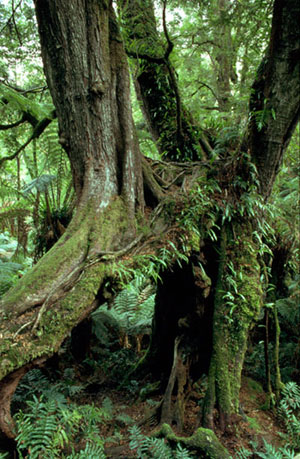 Myrtle Forest in the Otways
[Source: OREN]
.
Myrtle Forest in the Otways
[Source: OREN]
.Ed:
It is basically an inexpensive way for the Victorian Government to control weeds by utilising the free volunteer services of local interested community groups. Pertinent questions of accountability are what was the total fee of Beacon Ecological and what was the opportunity cost of that fee which could have instead applied the grant funding to directly deliver onground weeding by a professional bush regenerator?
.
.
Otways (200310)
.‘Greens sue timber union for ‘torment‘, by Fergus Shiel, Law Reporter, The Age (article), 20031013.
‘Eleven environment protesters are suing a group of forest workers, the timber workers’ union and its state secretary claiming they were held captive and tormented for five days during an anti-logging protest in the Otways four years ago. The six women and five men claim they were trapped by blockading and patrolling forest workers between January 25 and 29, 1999, at a logging coupe in the Beech Forest area of the Otways, near Apollo Bay.
In their statement of claim, filed with the Supreme Court, the conservationists variously allege that they were punched, kicked, dragged, wrestled and pushed, threatened with chainsaws, verbally abused and mentally harmed. Seventeen defendants, including the Construction Forestry Mining and Energy Union and the state secretary of its forestry division, Jane Calvert, are named in the action. The union denies all the allegations made against it.
The Trades Hall executive has condemned the court action, warning that the workers and their families could be bankrupted in defending the case. The case begins today in the Supreme Court before Justice David Ashley and is expected to run for up to 10 weeks.
“This case is significant because of the treatment the plaintiffs were subjected to. The fact that they are environmentalists is incidental,” Lawyers for Forests president Vanessa Bleyer said. CFMEU forestry division national secretary Michael O’Connor said: “The union will strenuously deny the allegations made against it and will vigorously defend this case.”
The conservationists say the union members refused to release them until they agreed in writing to stop all protests in the Otways individually and on behalf of the Otway Ranges Environment Network and the Wilderness Society. They claim they were kept awake at night by floodlights and loud music, had rocks and other objects thrown at their campsite and were spied on while going to the toilet during the episode. The conservationists allege Ms Calvert refused to intervene to prevent them from being intimidated, despite frequently being asked to do so.
Trades Hall Council secretary Leigh Hubbard said the legal action, regardless of its merits, was regrettable as it would not engender co-operation between environmentalists and the union movement. Each of the 11 plaintiffs is seeking unspecified damages, aggravated damages and exemplary damages against the defendants. They say they became increasingly frightened and distressed as the days dragged on.
By day three, one of the protesters was said to have been exhausted, tearful and on the verge of a nervous breakdown. The following day she was transported to hospital by ambulance. Two of the conservationists are claiming the cost of repairs to cars which they allege were deliberately damaged by forest workers during the 1999 incident.’
.
.
Otways (200301)
.
‘Pier-to-pub goes swimmingly‘, by Dan Silkstone, The Age (article), 20030112
‘The 23rd annual pier-to-pub swim went ahead with little disruption at Lorne yesterday, despite loggers clogging Geelong Road in a protest against the Bracks Government’s decision to phase out logging in the Otways Ranges. Organisers said they were delighted with a crowd estimated at more than 20,000, which saw a record 4000 competitors attempt the 1.2-kilometre swim.
“There was some disruption but it wasn’t that bad,” said event spokeswoman Samantha O’Brien. “People went by the back roads or left early. The day has been really successful and we’re extremely pleased.”
Three convoys of logging trucks left Geelong hourly starting at 8am, clogging lanes on the Geelong and Great Ocean Roads as they crawled toward Lorne at 40 kmh. A police spokeswoman said last night that no arrests were made and the protest had been peaceful.
The loggers were protesting against the State Government’s decision to halt logging in the Otways Ranges by 2008, a key part of the government’s re-election strategy.
Organiser Peter Dynes said despite timing the action to coincide with the race it had never been the loggers’ intention to stop the event or cause problems for the surf lifesaving club, which runs the race as a fund-raiser.
“I don’t think we disrupted the event and we didn’t want to do that,” he said. “We just wanted to get some attention and tell the public about the situation we are in.”
Mr Dynes accused Premier Steve Bracks of misleading loggers about the future of their jobs. He said that forestry workers and their families were already suffering as logging scaled back before the scheduled finish date. About 150 loggers travelled through Lorne, stopping for a barbecue while the race went ahead. A second planned blockade in the afternoon was cancelled as the protesters took up a collection for the lifesaving club.
For the record, Nick Hinsley won the event in a time of 11.49, the third consecutive occasion he has led all comers in the race to the beach in front of the Lorne Hotel. Naantali Marshall was the first woman home for the fourth consecutive year in 12.16.’
.
Otways (200211)
.
‘Easy Harvest of Urban Greenies‘, by Andrew Barnham, North Carlton, The Age (letter), 20021108.
.
‘Warm praise for The Age’s coverage of Steve Bracks’ logging pledge in the Otways and Wombat forests, exposing it for what it really is – little more than an easy harvest of urban environmentalist votes. The policy targets a section of our community that either possesses good intentions but is largely ignorant of the real issues facing the Victorian bush, or prefers to misrepresent its own selfish aesthetic as environmental concern. The Bracks Government appears to have no regard for communities such as Trentham that have the misfortune to be close to the haunts of the weekend rural latte set.
If those who posture concern for the environment were genuine, then they would find their interests closely ally with rural Victoria. Thus, I’d unhesitatingly vote for any party that placed reformation of DNRE and protection/repair of environmentally devastated areas such as the Alpine National Park near Licola on its agenda. Instead, the Greens and the major parties choose soft targets that have little merit.’
.
‘Lest We Forget‘, by Rob Buttrose, Port Melbourne, The Age (letter), 20021108.
‘Whether it is just politically expedient or not, the State Government’s decision to protect the Otways and Wombat state forests is a win for the environment and the community. We must not forget, however, the thousands of people who campaigned long and hard over many years on this issue, vilified and harassed by timber workers and police for their trouble. I was not one of them, but I salute their efforts.’
.
.
Otways (200102)
.
Hancock Watch website, ^http://hancockwatch.nfshost.com/directory/otways/LEGL93-48-1.html [Read More]
‘The Webster Hill plantation was likely sprayed with 245T (Dioxin) between 1968 and 1977. Lardners Creek, which forms part of the Gellibrand drinking water catchment involved clear fell logging between 2001 and 2004, including burning ito the water tributaries.’
.
.
.
Otways (200003)
.
‘Save Otways old-growth forests!’, Green Left, ^http://www.greenleft.org.au/node/22821
‘Geelong — People from across Victoria joined Geelong residents on March 4 to condemn a regional forest agreement which permits the woodchipping of old-growth forests in the nearby Otway Ranges. The 250-strong rally named Midway Wood Products the main villain. As they marched on the company’s plant, the protesters chanted, “RFA no way! Midway go away!”‘
.
.
Otways (199806)
.
‘Forest Gumption’, letter by Belinda Melzak, Hampton, The Sunday Age (Your Say), 19980628
.
‘Parks Victoria may well be proud. “We babysit one of Victoria’s oldest living inhabitants,” it advertised in The Sunday Age, referring to a picture of a glorious 170 year-old mountain ash tree in The Otway Ranges National Park. Unfortunately, it was of little relief to see that some of our forests are in good hands. The remainder of the Otways, which include many areas equal in age, beauty and biological significance to those referred to in the advertisement, are devoid of protection and are subject to constant interference and destruction.
The Otways are one of the few cool temperate rainforests – these forests and their associated vegetation occur only in the south-eastern corner of our continent and link flora directly to the ancient forests of the super continent Gondwanaland.
A study by the Geelong Environment Council in 1994 found that the reserve system (being the present area of the Otway National Park) is not sufficient to protect the rare and valuable areas that it houses. Logging and the natural process of aridification are a constant threat to their survival.
The Geelong Environment Council proposal to extend the present boundaries of the Otway National Park effectively triples its size and yet reduces native forest hardwood across our state by only 1 per cent. It would ensure the protection of unique flora and fauna for generations to follow, yet it has been ignored by those responsible for the care and maintenance of our forests. At present, about 80% of the timbers removed from the Otways are used for the woodchips, a large percentage of which is purchased for use in the production of toilet-tissue products. An interesting example of Jeff’s Victoria on the move!
As “babysitters” of our protected forests, Parks Victoria may be doing a good job. It’s a great pity that the rest of our valued inhabitants are left out in the cold to combat chainsaws, ignorant political policies and blinkered multinational companies.’
.
Otways (199708)
.
.
‘Every year about 300 hectares of Otway State forest are clear-felled by the Victorian Department of Natural Resources and Environment (DNRE) for woodchips and sawlogs.
In clear-felling, all the trees in a given area are removed, and the forest understorey is bulldozed and burnt. It is similar to clearing forest for agricultural purposes. The DNRE replants an even-aged crop of selected trees so that the native forest becomes a plantation.
Clear-felling is killing the Otway native forest. The habitat for forest birds and animals is being systematically destroyed.
Kimberly Clark, the manufacturer of Kleenex tissues, has a licence to buy 44,000 tonnes of whole trees from the Otways each year. This represents about 40% of all the Otway forest destroyed by clear-fell. Kimberly Clark requires hardwood woodchips to make tissue paper soft and smooth.
Research shows that up to 85% of tree ferns in a clear-fell area are destroyed. After two years, the remaining tree ferns are of poor health or diseased. No new tree ferns grow.
Myrtle beech rainforest is facing extinction from a dieback disease called myrtle wilt. Clear-felling spreads myrtle wilt disease, which is at epidemic levels in the Otways.
Studies on the effect of clear-felling in tall wet mountain forest indicate that vegetation adapted to a drier environment tends to regenerate after the operation. Drier forest environments increase the frequency and intensity of bushfires, which are a particular threat to rainforest.
Kimberly Clark is a US-based multinational. Amcor Ltd, another major multinational woodchipping company, has a 50% share and controlling interest in Kimberly Clark Australia.
In 1992, Kimberly Clark Australia used plantation eucalypt from Brazil to make tissue paper. To cut production costs, it changed to buying Australian woodchips. It knows that time is running out for the Otway forest and claims, on Kleenex packets, that it will begin harvesting its own eucalypt plantations by the year 2000.
Presumably, after that date, Kimberly Clark Australia will “phase out” its requirement for hardwood woodchips from the Otways. But by then the tiger quoll and cool temperate rainforest may also be phased out.
Boycott Kleenex! If just one in 10 people who buy the Kleenex brands below used an alternative product, Kimberly Clark would lose up to $18.6 million in retail sales.
Carter Holt Harvey is another manufacturer that uses native forest to make tissue paper. Brand names to avoid include Sorbent, Petal, Chiffon, Scotties, Snowtext and Earthcare.’
.
.
Otways (199702)
.
‘Haunting visits to the forests‘, letter by David Low, Barwon Heads, The Age, 19970217
.
‘In some of my recent trips through the Otway Ranges south-west of Melbourne, the damage due to logging is becoming quite evident and alarming. Why are we destroying our wilderness, on our land, for the profit of multinational companies ? Especially when they already have ample plantation resources to draw from. This short-sighted practice will ultimately destroy the tourism potential that this area has to offer.
The cool temperate rainforests of the Otways is the ideal accompaniment to the rugged coastline of the Great Ocean Road, the jewel of tourism exposure for Victoria. However, as you now drive along the Great Ocean Road, the pine plantations are becoming more noticeable and the destruction in less accessible areas is quite sickening. For proof just look at the river runoff. Time is rapidly running out for the beauty of this area and if the damage continues, then the loss of tourism potential and jobs in the area will be far greater than the logging industry has to offer.
Everybody can help through everyday actions. Watch your purchases, watch your politicians, be heard, not herded’
.
‘Otways are fraying round the ridges‘, letter from Wendy Kennon, for the Apollo Bay Landcare Group, The Age, 19970225
.
‘I refer to the recent letters concerning the destruction of the Otway native forests (17/2, 2012). On Saturday 8 February, the Apollo Bay Landcare Group and the Otway Ranges Environmental Network (OREN) held a rally in the Otway State Forest to protest the logging of the Wild Dog and East Barham Valleys and to consider ways of protecting the forest. The groups are concerned for the preservation of the beautiful ridges of the forest which are very visible from both Wild Dog Road and the main Skenes Creek-Colac Road in this important tourist area, but they have a deeper concern for the preservation of the untouched temperate rainforest that lies in the heart of these valleys.
Logging will do untold damage to the quality of the rivers and to the many native species that are to be found in the area, Including the endangered masked owl and tiger quoll. Although logging: companies are supposed to leave a buffer of same 50 metres around any rain forest when clear-fell logging it has been shown that this is insufficient to prevent severe drying of the surrounding area. Rainforest deteriorates when put under pressure in this way.
The Apollo Bay Landcare Group calls on the Government to stop logging in this sensitive area and to move to incorporate the area in the Otway National Park. Any interested person can contact the Apollo Bay Landcare Group (PO Box 281 Apollo Bay 3233) for more information.’
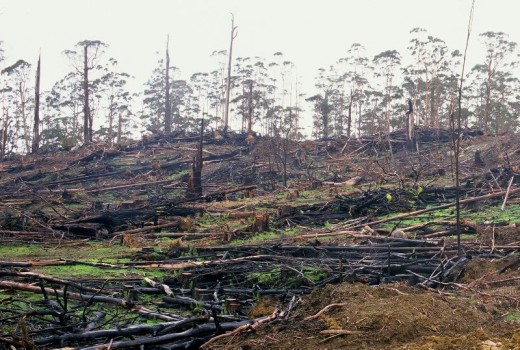 1997, before the campaign to save the Otways
1997, before the campaign to save the Otways[Source: OREN]






